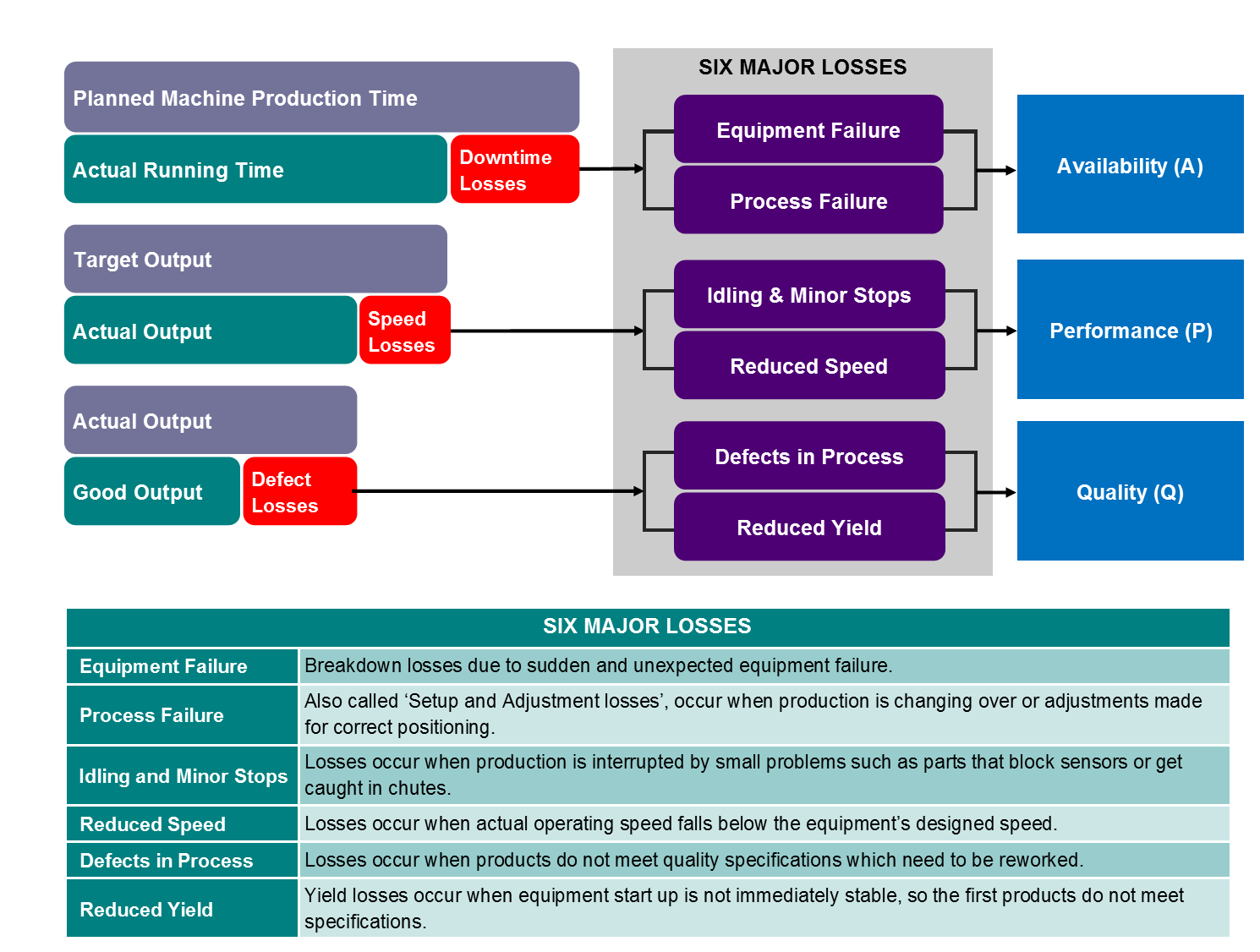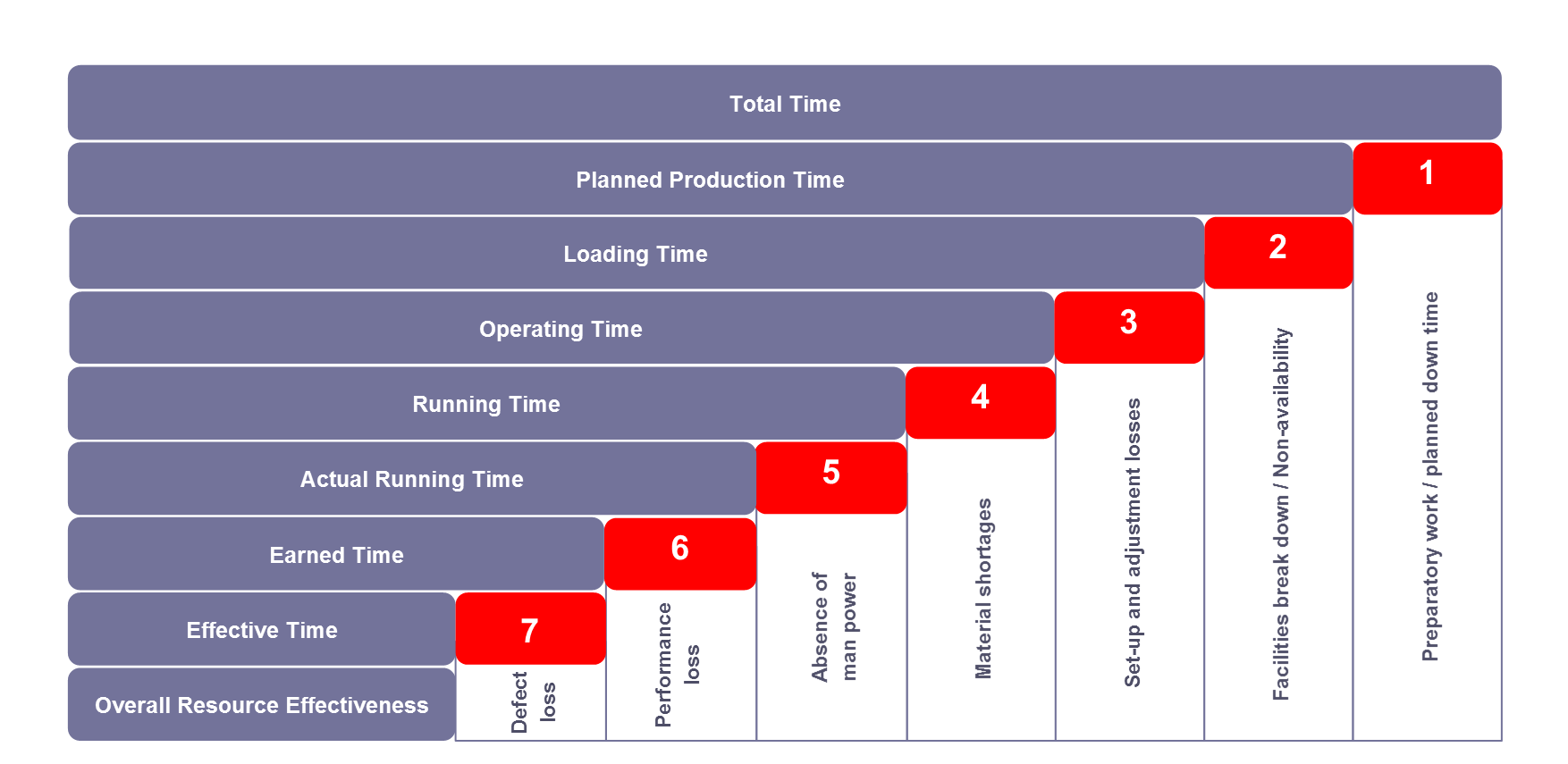In today’s globally competitive business environment, manufacturers continually strive to improve their performance by enhancing the production line’s effectiveness to meet the needs of an ever-changing market. Various lean manufacturing tools have been applied to make improvements in the productivity and reliability of the production process. Methods such as Total Productive Maintenance (TPM), launched by Nakajima (1988), have been implemented by many firms to maintain and improve the integrity of the production line. Overall Equipment Effectiveness (OEE), as a standardised operations performance metric of the TPM concept, allows manufacturers to benchmark against competitors in the same industry.
OEE, defined as a measure of overall equipment performance, identifies six major losses for ineffective performance of a production line based on its Availability, Performance and the Quality rate of the output. The Availability of equipment is affected by Downtime Losses – 1. Equipment Failure and 2. Process Failure. The Performance efficiency of equipment is affected by Speed Losses – 3. Idling and Minor Stops and 4. Reduced Speed. And the Quality rate of equipment is directly affected by Defect Losses – 5. Defects in Process and 6. Reduced Yield (last two losses).
The factors of six major losses and the structure of OEE are shown below:

Therefore,
Overall Equipment Effectiveness (OEE) = Availability (A) x Performance (P) x Quality (Q)
Where,
Availability (A) = Actual running time / Planned machine production time
Performance (P) = (Cycle time/unit x Actual Output) / Actual running time
Quality (Q) = (Total Production – Defect) / Total production
OEE is a top view metric indicating the gap between the initial and improved performance of a manufacturing unit. It categorises major reasons for poor performance of equipment, providing the basis for further analysis and improvement in a production process. However, although the concept behind OEE can be applied to multiple sectors and industries, OEE concentrates on the quality, performance and productivity of machines. It ignores other resources of a production line such as the usage of materials, the environment as well as man’s efficiency. Hence, a modified approach, Overall Resource Effectiveness (ORE) becomes a more applicable method to a broader range of industries for the measure of production process effectiveness. It addresses the losses associated with the resources and the new factors are known as ‘Readiness’, ‘Availability of Facility’, ‘Changeover Efficiency’, ‘Availability of Material’, ‘Availability of Manpower’.

Overall Resource Effectiveness (ORE) = Readiness (R) x Availability of Facility (Af) x Changeover Efficiency (C) x Availability of Material (Am) x Availability of Manpower (Amp) x Performance (P) x Quality (Q)
Overall Equipment Effectiveness (OEE) or Overall Resource Effectiveness (ORE)?
The difference between the two metrics in the measurement of production process effectiveness leads all manufacturers to a major question: What’s to be measured? Types of losses for production effectiveness vary across different industry sectors, even between two different production lines within the same manufacturing plant.
Production losses might be caused by factors that are beyond the company’s control such as third party logistics problems or environmental changes. Or those losses might be due to internal factors such as unqualified labour training, or other operation related losses.
The decision on choosing which metric to measure very much depends on your industry as well as the specification of your production lines. For example if the specialised labour skills are one of the most important resources in production process, ORE is without doubt the metric to choose; OEE is more applicable to be used in fully automated production environment to identify and optimize key performance indicators within a production line.
References:
Eswaramurthi, K.G., and Mohanram, P.V., 2013. Improvement of Manufacturing Performance Measurement System and Evaluation of Overall Resource Effectivement. American Journal of Applied Sciences, 10(2): 131-138, 2013
Muchiri, P., and Pintelon, L., 2006. Performance measurement using overall equipment effectiveness (OEE). International Journal of Production Research., Kuleuven, CIB